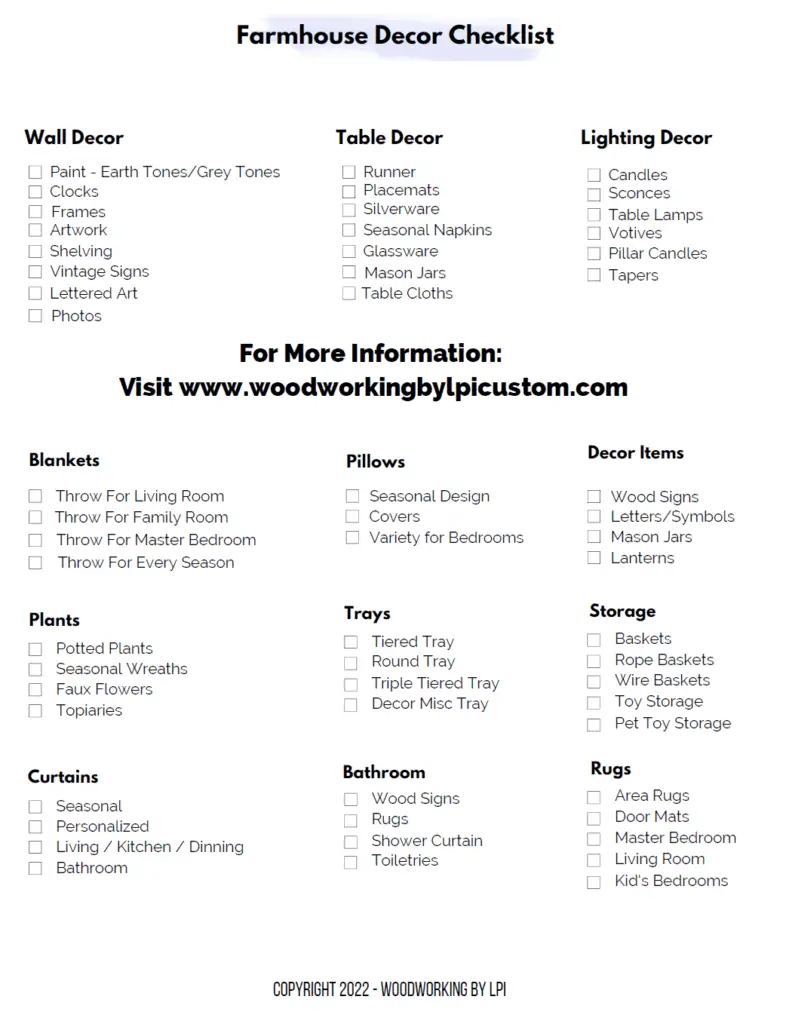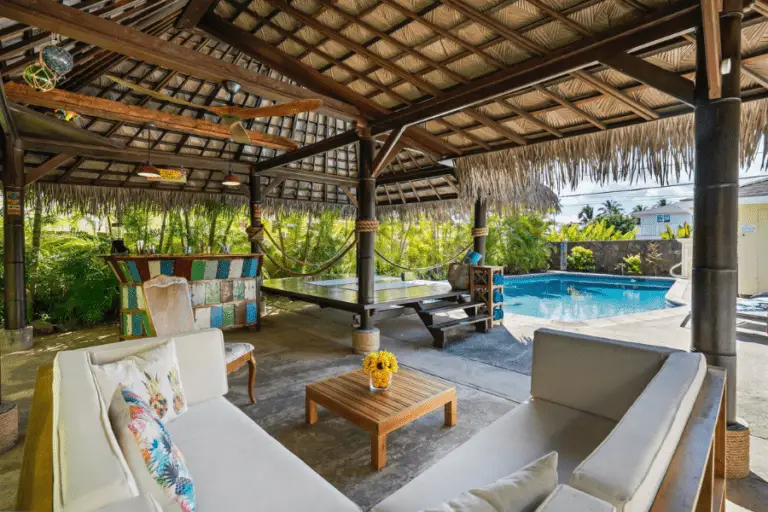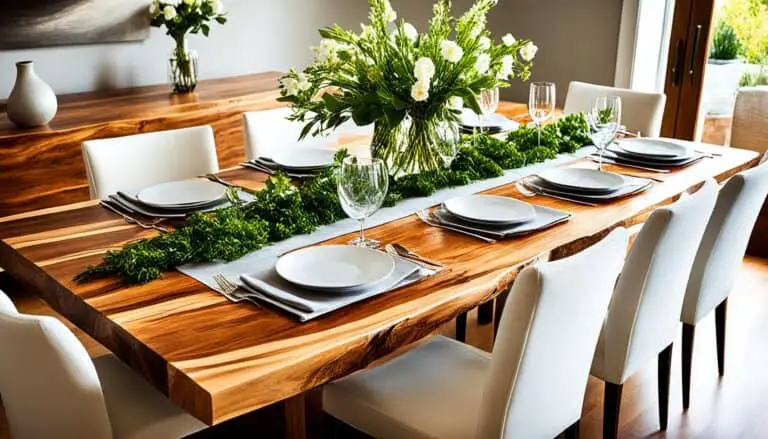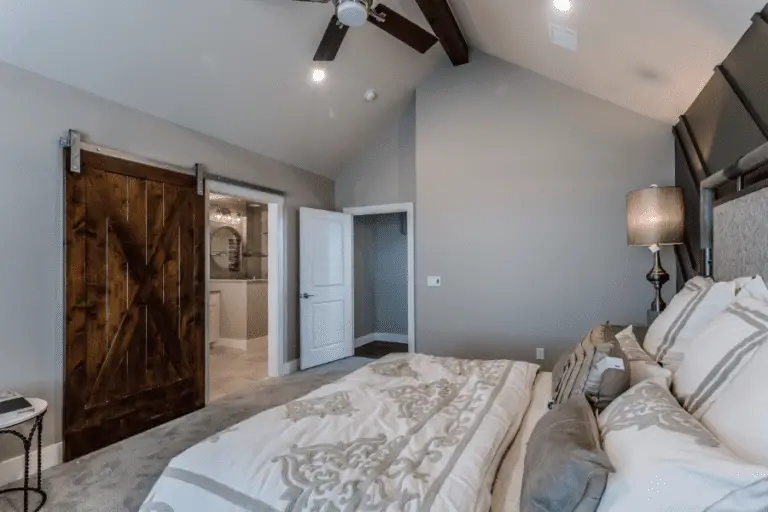Are you looking to create a cozy and inviting atmosphere in your backyard? What if we told you that you could do it yourself, without breaking the bank?
In this comprehensive guide, we will show you how to build your own cinder block fire pit, step by step. Whether you’re a seasoned DIY enthusiast or just starting out, this project is perfect for creating an affordable and stylish outdoor fire feature. Say goodbye to chilly evenings and hello to memorable nights around the fire.

Key Takeaways:
- Building a cinder block fire pit allows you to customize your outdoor space and create a cozy gathering spot.
- With the right guidance and materials, constructing a fire pit is an achievable DIY project for both beginners and experienced enthusiasts.
- Consider safety measures, such as proper ventilation and compliance with local regulations, to ensure a trouble-free fire pit experience.
- Choose the right location, fire pit shape, and design to complement your backyard aesthetics and functional needs.
- Enjoy the warmth and ambiance of your homemade fire pit, and don’t forget to share your success stories with others!
Choosing the Right Location and Fire Pit Shape
Before embarking on your DIY fire pit project, it’s crucial to carefully consider the location and shape of your fire pit. These decisions will not only affect the overall aesthetics but also impact the safety and functionality of your outdoor fire feature. Let’s explore the key factors to consider when choosing the right location and fire pit shape.
Fire Pit Location: Safety First
When selecting a location for your fire pit, prioritize safety. Identify an area that is at a safe distance from any structures, low hanging trees, or flammable materials. Ideally, there should be a minimum clearance of 10 feet around the fire pit.
Ensure that the location you choose provides adequate ventilation to allow smoke and heat to dissipate effectively. Avoid placing the fire pit in an enclosed or tightly confined space that could pose a fire hazard.
Fire Pit Shape: Square or Circular
Now, let’s explore two popular fire pit shapes: square and circular.
| Shape | Advantages |
|---|---|
| Square Fire Pit | Offers a modern and sleek appearance Allows for easy placement of seating and accessories Can be easily integrated into existing patio designs |
| Circular Fire Pit | Provides a classic and timeless look Allows for 360-degree seating and a cozy ambiance Enhances social interaction and conversation |
When deciding between a square or circular fire pit, consider your personal style, the surrounding landscape, and the desired functionality of your fire pit. Choose a shape that complements your outdoor space and meets your specific requirements.
If you’re unsure about the design or would like a more convenient option, fire pit kits are readily available in both square and circular shapes. These kits come with pre-cut blocks and detailed instructions, making the construction process easier, especially for DIY beginners.
However, it’s important to note that fire pit restrictions may vary depending on your location. Before proceeding with your DIY fire pit project, check local building codes and consult with your homeowner’s association, if applicable. Additionally, review your homeowner’s insurance policy to determine if disclosure of the fire pit is necessary.
By carefully considering the location and shape of your fire pit, you can create a visually appealing and functional outdoor space for gathering, relaxation, and enjoyment.
Preparing the Fire Pit Site and Gravel Base
Before you start building your fire pit, it’s essential to properly prepare the site and create a stable gravel base. By following these steps, you’ll ensure a solid foundation for your fire pit and enhance its longevity and stability.
1. Marking the Work Area
Begin by outlining the footprint of your fire pit and marking the work area. For a circular fire pit, drive a stake at the center and tie a string to it. With marking paint, draw a circle around the stake, ensuring the desired size and shape of your fire pit. If you’re building a square or rectangle fire pit, temporarily lay out the first layer of blocks and use a shovel to outline the perimeter.
2. Excavating the Area
Once the work area is marked, it’s time to excavate. Use a shovel to remove the sod and dirt to a depth of about 7 inches. Ensure that the excavation is even and level throughout the marked area.
3. Leveling the Excavated Area
To achieve a level surface, use a hand tamper to compact the excavated area. This step is crucial for the stability of your fire pit. Apply even pressure as you tamp down the soil until it feels solid and firm. Checking the level periodically will help you achieve an even surface.
4. Creating a Gravel Base
Adding a gravel base will provide the necessary stability for your fire pit. Pour approximately 5 inches of gravel onto the leveled area. Use a rake or shovel to distribute the gravel evenly, ensuring it covers the entire excavated space. Once the gravel is spread out, use a hand tamper to compact it thoroughly, making sure it is solid and firmly packed.
With your fire pit site prepared and a sturdy gravel base in place, you’ve set the foundation for a successful fire pit construction. The next step is to start building the fire pit structure itself, which we will cover in the next section.
Building the Fire Pit
Now that you have prepared the fire pit site and created a sturdy gravel base, it’s time to start building the fire pit itself. This section will guide you through the process, including fire pit block layout, bowl fitting, adhesive usage, layering, and curing time.

Here’s a diagram illustrating the steps for constructing a simple circular fire pit in your backyard. It shows a cross-sectional view of the ground, detailing each layer and component required for the project, including marking the location, digging a trench, laying a gravel base, arranging fire-rated bricks or stones, filling gaps with sand, and optionally installing a metal fire ring. Each step is clearly labeled for easy understanding and implementation.
Step 1: Laying Out the First Layer of Blocks
Begin by placing the first layer of blocks on top of the gravel base. Make sure the sides of the blocks are touching and aligned properly. To maintain a consistent height, use a level to check and adjust the blocks if necessary. If any blocks are raised higher than others, gently tap them down using a rubber mallet or add leveling sand underneath.
Step 2: Test-Fitting the Fire Pit Bowl
Before moving on to the next layer, it’s essential to test-fit the fire pit bowl. Place the bowl in the center of the first layer of blocks to ensure a proper fit. Make any adjustments if needed, such as widening the opening or raising the layer of blocks to accommodate the bowl’s size and shape.
Step 3: Securing the Blocks with Adhesive
Once the first layer is in place and the bowl fits correctly, it’s time to secure the blocks together using fire pit adhesive. Apply the adhesive between the layers of blocks, ensuring a strong bond to create sturdy fire pit walls. Repeat this process for each layer of blocks, making sure the blocks are level and aligned for a uniform look.
Step 4: Layering the Blocks
A typical fire pit consists of three or four rows of blocks. As you continue to layer the blocks, make sure to follow the design and adjust the opening size if necessary. Use the same adhesive application technique between each layer to ensure stability and durability.
Step 5: Allowing Curing Time
After completing the construction of your fire pit, it’s crucial to allow the adhesive to cure for the recommended time. Curing time ensures that the adhesive forms a strong and long-lasting bond between the blocks. Check the adhesive packaging for specific curing instructions. Avoid using the fire pit until the adhesive has fully cured to prevent any potential issues.

Now that you have built your fire pit, the next section will explore various design ideas to enhance your outdoor space and create a unique ambiance around your new fire feature.
Here are some common questions users may have about building fire pits, along with answers to address their concerns:
- Safety Concerns:
- Question: Is it safe to have a fire pit in my backyard?
- Answer: Fire pits can be safe if built and used properly. Ensure the fire pit is placed on a non-combustible surface, away from overhanging branches or structures. Always supervise the fire and have a fire extinguisher or water source nearby.
- Question: What precautions should I take to prevent accidents with a fire pit?
- Answer: Keep children and pets away from the fire pit, and establish a clear safety zone around it. Never leave the fire unattended, and avoid using accelerants like gasoline to start or fuel the fire.
- Question: Is it safe to have a fire pit in my backyard?
- Material Options:
- Question: What materials can I use to build a fire pit?
- Answer: Common materials for fire pits include fire-rated bricks, natural stone, concrete blocks, and metal. Each material offers different aesthetics and durability, so choose one that fits your budget and design preferences.
- Question: Are there any eco-friendly options for fire pit materials?
- Answer: Yes, you can opt for natural stone or recycled materials like salvaged bricks or metal. These options are environmentally friendly and add a unique character to your fire pit design.
- Question: What materials can I use to build a fire pit?
- Design Ideas:
- Question: What are some popular fire pit designs?
- Answer: Popular fire pit designs include circular or square pits with built-in seating, sunken fire pits surrounded by retaining walls, and portable fire bowls or chimineas. You can also customize the design to fit your backyard style, whether it’s rustic, modern, or traditional.
- Question: Can I incorporate additional features into my fire pit design?
- Answer: Yes, you can enhance your fire pit with features like cooking grates, spark screens, or gas burners for convenience. Additionally, consider adding seating options, ambient lighting, or landscaping elements to create a cozy outdoor gathering space.
- Question: What are some popular fire pit designs?
By addressing these common questions, users can gain a better understanding of the considerations and options available when building a fire pit, ensuring a safe and enjoyable outdoor experience.
Fire Pit Design Ideas
When it comes to designing your cinder block fire pit, the possibilities are endless. Whether you prefer a simple and minimalist style or a more luxurious and intricate design, there are plenty of options to choose from. Here are some fire pit design ideas to inspire you:
1. Simple Fire Pit
If you appreciate clean lines and a minimalist aesthetic, a simple fire pit design is a great choice. This design focuses on functionality and practicality, providing a cozy outdoor gathering space without any frills or embellishments.
2. Gravel Fire Pit
A fire pit surrounded by gravel can add a rustic and natural touch to your backyard. The gravel acts as a visually appealing base and provides a defined area for your fire pit. You can choose different colors or sizes of gravel to achieve the desired look.
3. Cinderblock Fire Pit
An all-cinderblock fire pit is a classic and versatile option. With its sturdy construction and industrial charm, a cinder block fire pit can blend seamlessly with various outdoor styles. You can play with the block layout to create unique patterns or add a decorative touch.
4. Modern Concrete Fire Pit
For a sleek and contemporary fire pit design, consider using concrete blocks or slabs. This modern approach can create a statement piece in your outdoor space, complementing a modern or minimalist design aesthetic.
5. Stacked Stone Fire Pit
A stacked stone fire pit exudes elegance and sophistication. The natural beauty of the stones adds texture and visual interest to your outdoor area. You can choose different types of stones and play with their arrangement to achieve the desired effect.
6. Koi Pond Fire Pit
If you’re looking for a truly unique and eye-catching design, why not integrate your fire pit with a koi pond? This innovative concept combines the relaxing ambiance of a fire pit with the tranquility of a koi pond, creating a stunning focal point in your backyard.
7. Upcycled Fire Pit
If you have a knack for creative DIY projects, consider upcycling materials to build your fire pit. You can repurpose old car rims, metal barrels, or even discarded furniture to create a one-of-a-kind fire pit that reflects your ingenuity and resourcefulness.
8. Tree Stump Fire Pit
Another creative and natural option is to use a tree stump as the base of your fire pit. This design adds a touch of whimsy and rustic charm to your outdoor space, making it a conversation starter and a unique feature in your backyard.
Whether you prefer a simple and minimalist style or a more elaborate and innovative design, these fire pit ideas can help you create a cozy and inviting outdoor space. Consider your personal style, the overall aesthetic of your backyard, and the functionality you desire when choosing the design that suits you best.
Fire Pit Safety Measures
Safety should always be a top priority when it comes to constructing and enjoying your fire pit. By following these essential safety measures, you can ensure a safe and enjoyable experience for you and your loved ones.
Proper Positioning
When selecting the location for your fire pit, it is important to consider fire pit positioning to ensure safety. Choose an area that is a safe distance from structures, trees, and any other flammable materials. This will reduce the risk of accidental fires and potential damage to property. Additionally, make sure the area is well-ventilated to prevent smoke from entering nearby structures or causing discomfort to your guests.
Preparation is Key
Before lighting your fire pit, take the necessary precautions to ensure a safe environment. Clear any vegetation, debris, or combustible materials from the area surrounding the fire pit. This will minimize the risk of sparks igniting nearby objects. Additionally, create a designated seating area away from the fire pit to prevent accidental contact with hot embers or flames.
Safe Lighting Practices
When it comes to lighting your fire pit, it’s important to use safe methods to avoid accidents and injuries. Never use flammable liquids, such as gasoline or lighter fluid, to ignite the fire. Instead, use commercially available fire starters or kindling to get the flames going. Keep a safe distance from the fire when lighting it, and always have a lighter or long match on hand to avoid getting too close to the flames.
Constant Supervision
Never leave your fire pit unattended, especially when it’s lit. Fires can quickly spread if precautions are not taken. Ensure that there is always someone responsible for monitoring the fire and keeping a close eye on its activity. This person should also be prepared to act quickly in case of emergencies or if the fire needs to be extinguished.
Fire Extinguishers and Water Sources
Having a fire extinguisher or water source nearby is essential for fire pit safety. In case of an emergency or if the fire needs to be extinguished, these resources are crucial in quickly and effectively putting out the flames. Make sure everyone knows the location of the fire extinguisher or water source and how to use them properly. Remember, always prioritize your safety and the safety of others above all else.
Proper Extinguishing
Extinguishing the fire properly is just as important as lighting it safely. Before leaving the fire pit unattended, ensure that the fire is completely out. This can be achieved by carefully pouring water over the fire and stirring the ashes to cool them down. Keep in mind that the area around the fire pit should also be cool before leaving to prevent any potential hazards. Always err on the side of caution and take the necessary steps to ensure the fire is fully extinguished.
| Fire Pit Safety Tips |
|---|
| Properly position your fire pit to prevent accidents and fires. |
| Clear vegetation and debris from the fire pit area to minimize the risk of sparks igniting nearby objects. |
| Avoid using flammable liquids to light the fire pit. Instead, use commercially available fire starters or kindling. |
| Never leave your fire pit unattended and always have a responsible person in charge of monitoring the fire. |
| Keep a fire extinguisher or water source nearby in case of emergencies or if the fire needs to be extinguished. |
| Ensure the fire is completely out and the area is cool before leaving the fire pit unattended. |
Sources for Safety In Your Design
- National Fire Protection Association (NFPA):
- Source: The NFPA offers comprehensive guidelines for fire safety, including outdoor fire pits.
- Link: NFPA’s Outdoor Fire Pit Safety Tips
- University of California Cooperative Extension:
- Source: The UC Cooperative Extension provides research-based information on various topics, including outdoor fire pit safety.
- Link: UCCE’s Safe Outdoor Fire Pits
- DIY Network:
- Source: DIY Network offers practical advice and tutorials for DIY projects, including building fire pits.
- Link: DIY Network’s Guide to Building a Fire Pit
- HomeAdvisor:
- Source: HomeAdvisor provides insights and tips for homeowners, including guidance on building fire pits.
- Link: HomeAdvisor’s Tips for Building a Fire Pit
- Bob Vila:
- Source: Bob Vila offers comprehensive guides and resources for home improvement projects, including fire pit construction.
- Link: Bob Vila’s Step-by-Step Guide to Building a Fire Pit
User-Generated Content and Testimonials
The success of a DIY fire pit project using cinder blocks is best showcased through user-generated content and testimonials. Real-life success stories and experiences from individuals who have built their own fire pits can serve as valuable inspiration and guidance for others embarking on similar projects.
“Building a cinder block fire pit was a game-changer for our outdoor space. We followed the step-by-step guide and were amazed at how easy it was to create a functional and stylish fire pit. Now, we enjoy cozy nights by the fire with family and friends.”- Emily, DIY enthusiast
By incorporating testimonials like Emily’s, you can provide readers with genuine accounts of the satisfaction and success that comes from DIY fire pit projects. These stories create a sense of trust and reliability, instilling confidence in readers and motivating them to embark on their own fire pit journey.
Alongside testimonials, user-generated content can add even more value. Sharing images and videos of completed fire pit projects allows individuals to see the end results and visualize the potential of their own designs. From simple and minimalist fire pits to intricate and unique creations, user-generated content showcases the creativity and personalization that can be achieved.
Additionally, customer reviews provide another layer of insight and feedback. By sharing reviews from individuals who have purchased fire pit materials or accessories, you can help readers make informed decisions and discover new products that enhance their DIY fire pit projects.
Fire Pit Success Stories
Here are some fire pit success stories shared by DIY enthusiasts:
- Alex built a cinder block fire pit using a circular design and incorporated a grill grate for versatile outdoor cooking.
- Nathan transformed an unused corner of his backyard into a cozy outdoor oasis with a modern concrete cinder block fire pit.
- Stephanie combined her love for gardening and fire pits by integrating a koi pond into her circular cinder block fire pit.
These success stories not only highlight the creative possibilities of DIY fire pit projects but also provide practical tips and recommendations based on firsthand experiences.
Whether it’s through testimonials, user-generated content, or customer reviews, incorporating authentic and relatable experiences can inspire readers to embark on their DIY fire pit journey with confidence and enthusiasm.

Conclusion
Building a cinder block fire pit can be a rewarding and enjoyable DIY project that adds value and functionality to your outdoor space. By following the step-by-step guide provided in this article, considering safety measures, and exploring different design ideas, you can create a durable and affordable fire pit that suits your style and needs.
Throughout the construction process, it is essential to prioritize safety by positioning the fire pit away from flammable materials, clearing the area, and using safe lighting methods. Additionally, adhering to local regulations and ensuring proper fire extinguishing practices will further enhance the safety of your outdoor fire feature.
There are numerous design options available for your cinder block fire pit, from simple and minimalist designs to more elaborate and unique concepts. The key is to let your creativity shine and customize the fire pit to reflect your personal style. Don’t be afraid to share your success stories and experiences with others, as they can inspire fellow DIY enthusiasts and provide valuable insights.
So, whether you’re looking to create a cozy space for relaxing with loved ones or hosting outdoor gatherings, building a cinder block fire pit is a fantastic way to enhance your outdoor living area and enjoy the warmth and beauty of a homemade fire feature.
FAQ
What is a cinder block fire pit?
A cinder block fire pit is a DIY outdoor fire feature constructed using cinder blocks. It provides a cost-effective and customizable option for creating a backyard fire pit.
How do I choose the right location and fire pit shape?
When selecting a location for your fire pit, ensure it is a safe distance from structures and low-hanging trees. You can choose between square or circular fire pit designs based on your preferences and available space.
What do I need to do to prepare the fire pit site and gravel base?
Before construction, mark the fire pit area, remove sod and dirt, level the excavated area, and create a gravel base for stability.
How do I build a cinder block fire pit?
Start by laying out the first layer of blocks on a gravel base, ensuring they are level and touching. Secure the blocks with construction adhesive, repeating the process for additional layers.
What are some fire pit design ideas?
There are various design ideas to consider, including simple and minimalist designs, fire pits surrounded by gravel, modern concrete fire pits, stacked stone fire pits, and even fire pits integrated with koi ponds.
What safety measures should I take when using a fire pit?
It is important to position the fire pit a safe distance from structures and flammable materials, clear vegetation around it, use safe lighting methods, never leave the fire unattended, and have a fire extinguisher or water source nearby.
Can you provide user-generated content and testimonials?
Yes, we have success stories from individuals who have built their own cinder block fire pits. They have shared their DIY projects and experiences, providing additional insights and tips for fire pit construction.








